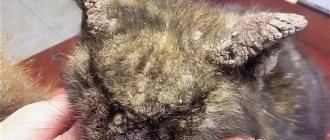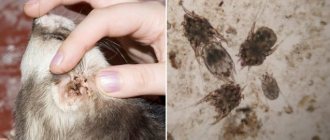Ear mites or otodectosis are a fairly common disease not only among stray cats, but also widespread among pets. And the manifestation of this disease should not be taken lightly. The consequences of neglected painful damage to the cat's body by ticks can be very serious.
Every cat owner should have a clear understanding of the disease picture and know what to do if a tick is detected on their pet. You should also know what an ear mite looks like.
Getting rid of ear parasites can sometimes be quite difficult, so timely treatment and preventive measures are the key to the health of your beloved cat.
Where does it come from - the causes of occurrence
The question “where do ear mites come from in cats” most often worries pet owners, who sometimes never even go outside. The causes of otodectosis can be not only direct contact with stray animals, but also indirect routes of transmission of the disease.
It is known that a cat can acquire this parasite by sharing care items with an infected animal. Ticks are transmitted through a towel or comb.
The leading position as a source of infection is still occupied by homeless animals. They account for about 80 percent of the total number of cases of infection. The anatomical structure of the cat's auricle serves as an additional risk factor for the occurrence of this disease. The cat's owner can also become a carrier of ear mites on clothes, shoes, and even hands. In a kitten, ear mites can occur as a result of infection from the mother.
Prevention of infection
It is no secret that preventing any disease, including otodectosis, is easier than treating it. For prevention purposes, the following rules should be observed:
- Carry out regular inspection and cleaning of your pet’s ears;
- avoid contact with suspicious animals;
- strengthen the cat’s immunity by adhering to the principles of proper nutrition, as well as ensuring that the pet takes the necessary vitamins;
- maintain pet hygiene;
- If you suspect the presence of a tick, you should immediately visit a specialist.
Ear mites in cats: signs and symptoms
You can see what the picture of ear mite disease looks like in the photo. Click to enlarge.
The highest percentage of mite infestation occurs in kittens aged 1 to 6 months and in older or weakened cats.
How can you tell if your pet is suffering from ear mites? There are a number of signs indicating the presence of this arthropod parasite.
The main symptoms of the disease are as follows:
- The animal shakes its head frequently, and a rattling sound may be heard.
- Black wax builds up in the ears, which can lead to stone-like plugs.
- When a cat shakes its head, liquid droplets may spray from the ears.
- Bleeding scratches form in and around the auricle.
- As a result of pus draining from the ears, the hair around the ear may become sticky.
- High body temperature.
- Nervous attacks.
- The cat's constant desire to scratch the affected ear.
- Nervous, restless behavior, sometimes even aggression on the part of the cat.
- Unpleasant odor from the ears.
The listed signs may be complemented by an atypical tilt of the head with the affected ear drooping down. If you have such symptoms, you should consult a doctor to decide how to treat your pet.
Diagnosis of otodectosis
In a veterinary clinic, the diagnosis is made based on examination and examination of the contents of the ear under a microscope.
Basic methods:
- Using a special instrument, the doctor sees moving white dots.
- Studying sulfur under a microscope allows you to examine adults, larvae and eggs.
- The "positive ear" method. The doctor wipes the ear canal, and the cat reacts by trying to scratch with its hind paw.
If inflammation (otitis media) has developed, diagnosis becomes difficult. The fact is that with otitis media, an acidic environment is created in the ear, in which parasites die. Therefore, microscopy may not show results.
Also, before treating for otodectosis, the doctor must exclude other diseases that lead to inflammation of the outer ear: allergies, flea dermatitis and other types of parasites.
Why are ear mites dangerous in cats?
The consequence of advanced ear mite infection in cats can be the development of a serious inflammatory process, which subsequently leads to rupture of the eardrum and hearing loss.
In severe cases, the tick may penetrate the inner ear and damage the lining of the brain. Evidence of an advanced process is systematic seizures that are similar to epileptic ones. This symptomatology can lead to death and the inevitable death of the pet.
Pathogen
Ear mites are quite common in cats. It belongs to the cutaneous category, so it can only live on the body of an animal. It will not be difficult to notice it in a cat’s ear - it is an oval-shaped body, reaching 0.5 mm in length. It is most often located in the ear folds.
Ear mites on a cat photo
The mite infects the external auditory canal, eardrum and inner surface of the ear of kittens. They are more susceptible to this kind of disease. Adult cats and male cats suffer from otodectosis less often. A person should not be afraid that his pet will infect him with this unpleasant disease. It does not apply to humans, although he can be a carrier of parasites if they get on his clothes or shoes.
Are ear mites dangerous for humans?
The question of whether ear mites can be transmitted to humans and whether they can be contracted from pets has an ambiguous answer. The risk of otodectosis for humans is a small percentage.
It has been scientifically proven that the dangerous disease is not transmitted to humans. Still, some experts recommend caution when interacting with a sick pet. It is possible that otitis may develop in people with weakened immune systems when caring for an infected animal without following safety precautions.
Treatment of ear mites in cats
Ridding your pet of ear mites at the onset of the disease will not be difficult. If you notice symptoms indicating a possible infection in your pet, you should immediately consult a doctor. You cannot diagnose or treat your pet on your own! Why?! Because this can aggravate the situation and waste time, and in the meantime the disease can move to the next stage.
Only a doctor determines how to treat otodectosis, taking into account the stage of the disease, the age of the animal, its state of health, and the presence of pregnancy in cats.
With the help of special medications, ear diseases are treated with great success. A prerequisite before treating the ears is to clean them.
This should be done as follows:
- A cotton pad or cotton swab is moistened in one of the products - chlorhexidine or 2% hydrogen peroxide solution, or camphor alcohol
- Cleaning the ears
- Then apply the amount of ointment specified by the doctor or instill the required number of drops.
- The auricle is gently massaged at the base to distribute the product evenly.
It is worth remembering that parasites can live on a cat's body, so antiparasitic drugs should be used on the entire surface of the body. During the treatment period, it is necessary to provide the cat with a varied fortified diet and access to fresh air. To kill ticks indoors, you should clean with acaricidal agents.
Rules for cleaning ears at home
Before carrying out the procedure, be sure to clean your cat's ears. This must be done regardless of the drug used, even if there is no such indication in the instructions for it.
As tools you will need:
- cotton pads to remove plaque;
- cotton swabs (it is not recommended to use homemade devices in the form of cotton wool wound around a match, this can cause damage if you are careless);
- cleaning agents (chlorhexidine, hydrogen peroxide, boric acid solution at a concentration of 3%).
Advice: if your pet is not accustomed to this kind of event or has an intractable character, arm yourself with a towel or sheet in which to swaddle the animal.
The sequence of the procedure for cleaning a pet's ears:
- Place the cat on your lap after covering it with a blanket. Calm down. Remember that for the animal, your desire to cure it is still perceived as a stressful situation.
- Gently bend the auricle and wipe the surface from dirt.
- Gently clean the affected area with a cotton swab soaked in a disinfectant solution. Never pick an animal's ear with pressure.
- Apply the drug. Massage lightly.
- Give the cat a chance to shake its head. Afterwards, wipe the inside of the ear and the hair around it with the same composition.
Medicines
To treat ear mites, medications are used in the form of sprays, powders, ointments, solutions, as well as injections.
At the initial stage, the following is prescribed:
- "Amit"
- "Acromectin"
- "Amitrazine"
- "Tactician"
Special preparations in the form of sprays, such as Tsiodrin, Acrodex, Dermatosol, can simply be sprayed on the area of the affected ear, approximately at a distance of 5 -5.5 cm from it.
To reduce the appearance of itching and relieve inflammation, Otonazole drops are prescribed. Ointments with sulfur compounds can be called effective - Sulfur ointment, Vishnevsky ointment.”
In advanced stages of the disease, Otodectin is used.
What procedures provoke an exacerbation?
Even after treatment, the skin is vulnerable to external influences, not to mention skin that has not undergone therapy, since its protective functions are significantly reduced. As noted earlier, other exacerbation factors include some cosmetic procedures:
- phototherapy and laser coagulation - these procedures help to increase temperature and increase blood flow to the skin, and at the same time increase the production of sebum (and this is simply an ideal environment for subcutaneous mites);
- massages, vaporization, ultraviolet exposure (in a solarium, for example) - also contribute to increased sebum production, and therefore should be excluded from the list of procedures until remission is achieved;
- chemical peeling - in the acute stage of the disease, aggressive acids only contribute to the proliferation of mites, however, this procedure is sometimes effective in combating residual effects on the skin (everything is very individual);
- Skin biorevitalization is one of the most popular anti-aging procedures, but during periods of exacerbation of the disease it is contraindicated.
Folk remedies for ear mites in cats
Folk remedies are used purely at the initial stage.
The following folk remedies for ear mites in cats are successfully used at home
- Brewing green tea. Place in ears several times a day.
- Infuse a mixture of ½ clove of garlic and 2 tablespoons of almond oil for 24 hours, and after straining through gauze, lubricate the ears with it once a day. Reviews from owners indicate the effectiveness of using pure almond oil, without adding garlic.
How long does it take to treat ear mites in cats?
A cat affected by ear mites can be quickly cured only if the disease is detected in the early stages. If the process is neglected, you will have to fight for a long time. It will be necessary to carry out a full course of treatment, which can last from 7 to 10 days. The treatment process, in order to completely remove ticks, cannot be stopped before the specified period.
After a successful course of treatment, the black contents in the ears disappear. In this case, the black plaque changes its color to brown.
Preventing ear mites in cats
Prevention of ear mite infection involves eliminating contact between your pet and street animals. Ear mites in a cat can result from other factors. It is necessary to examine the cat every time after a visit to the clinic, mating in someone else's house, or a walk on the street. You should avoid using items from other animals and carefully monitor your pet’s hygiene and health. The cat should not be allowed to rub against outdoor shoes or clothing. It is necessary to carry out mandatory wet cleaning in the house with special anti-tick products.
Symptoms
A tick in a cat's ear will make itself felt literally from the moment it appears.
- The animal begins to show anxiety and try to scratch its ears in any possible way: with its paws, by rubbing against hard surfaces. Constant itching will make her nervous and aggressive. In addition, constant attempts to scratch the ear will lead to scratches and open wounds that may become inflamed and begin to fester, so the itching will intensify. It is impossible to let the disease progress to such a state, as this may result in the eardrum bursting and the inflammation penetrating deeper into the inner ear.
- The cat begins to shake its head frequently, trying to get rid of the cause of scabies in the ear.
- Swelling is observed in the areas where the tick is located due to the fact that the vessels are overflowing with blood.
- On damaged surfaces there is exudate - liquid secretions. When it dries and mixes with skin particles and waste products of mites, brown scabs appear.
- The ear canal becomes crusty and then plugged.
- Even from a distance you can smell an unpleasant odor from a cat's ear.
- At a later stage of the disease, purulent masses stick together the fur at the base of the ear.
- In the later stages of the disease, your cat may experience hearing loss, although this can be difficult to test.
- An indirect sign of ear mites in cats may be fever or lethargy.
Ear mite photo
If any of these signs occur, and especially if they are accompanied by an increase in temperature, you should contact your veterinarian for professional help.
Veterinarian advice
Veterinarians specializing in the treatment and prevention of feline ear diseases recommend that cat owners use special flea and tick collars to protect their pets. After an illness, re-infection may occur, since immunity to this parasite is not developed.
Video with veterinarian advice:
By paying close attention to the problem of ear mite infestation, you can achieve a positive result and save your animal from a serious illness. Timely and high-quality treatment will return your pet to health and leave no chance for ticks.











